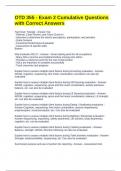OTD 355 - Exam 2 Cumulative Questions
with Correct Answers
Top Down Triangle - Answer-Top
- Referral, Chart Review, and Team Check-In
- Interview to determine the client's perceptions, participation, and priorities
- Quick Screens
- Functional Performance Evaluation
- Assessment of specific skills
Bottom
Why Evaluate ADL's? - Answer-- Great starting point for all occupations
- Many ADLs must be accomplished before moving onto IADLs
- Provides a reference point for the rest of intervention
- ADLs are important to complete successfully
- Track outcomes and progress
Explain how to assess multiple client factors during Grooming evaluation - Answer-
AROM, cognition, sequencing, fine motor coordination, perception can also be
evaluated
Explain how to assess multiple client factors during UB Dressing evaluation - Answer-
AROM, cognition, sequencing, gross and fine motor coordination, activity tolerance,
balance, etc. can also be evaluated
Explain how to assess multiple client factors during LB Dressing evaluation - Answer-
AROM, cognition, sequencing, gross and find motor coordination, balance, LE strength,
etc. can also be evaluated
Explain how to assess multiple client factors during Eating / Swallowing evaluation -
Answer-Cognition, sequencing, fine motor coordination, sensory impairments,
proprioception, visual perception, etc. Can also be evaluated
Explain how to assess multiple client factors during Bathing / Showering evaluation -
Answer-Sequencing, impulsivity, safety awareness, UE function, body awareness,
cognition, etc. can be evaluated
Explain how to assess multiple client factors during Toileting evaluation - Answer-
Balance, strength, AROM, direction following can also be evaluated
Explain how to assess multiple client factors during Toilet transfers evaluation - Answer-
Strength, balance/stability, sequencing, etc. Can also be evaluated
Summarize purpose and use of section GG reporting - Answer-- Assessment tool
,- Tracking functional performance used at admission and discharge
ADL goal setting in ICU - Answer-By discharge, Mr. Jones will wash face independently
while sitting EOB using BUEs.
ADL goal setting in Acute Care - Answer-Within 5 days, Mr. Jones will complete upper
body dressing while sitting EOB with min A for threading L UE into sleeve.
ADL goal setting in Inpatient Rehab - Answer-In 2 weeks, Mr. Jones will be able to
prepare a sandwich with BUE use while standing at the counter with SBA for safety.
ADL goal setting in Home Health - Answer-In 4 weeks, Mr. Jones will be able to
complete morning grooming tasks (shaving, washing face, and brushing teeth)
independently while standing at the sink.
ADL goal setting in Outpatient - Answer-In 4 weeks, Mr. Jones will be able to don and
doff a zip-up jacket independently using bilateral upper extremities while standing.
ADL evaluation in Outpatient - Answer-BADLs and IADLs important to client
ADL evaluation in Inpatient Rehab - Answer-GG reporting (previously FIM) dictates
BADL areas. Also include other IADLs important to client if appropriate.
ADL evaluation in Home Health - Answer-BADLs and IADLs important to client
ADL evaluation in Acute Care - Answer-- Basic ADLs with a focus on what the client
needs to be able to do to move to the next level of care.
- If plan is home alone, all BADL safely.
- If plan is SNF, as much BADL as tolerated.
- If plan is rehab, client must be able to tolerate 3 hours of therapy. ADL tolerance and
exposure for practice and repetition.
ADL evaluation in ICU - Answer-Grooming, face washing in bed or at edge of bed. May
transfer to a chair to do basic ADLs.
Executive Function Performance Test (EFPT) - Answer-- Used to provide a
performance-based standardized assessment to determine:
-- Which executive functions are impaired
-- An individual's capacity for independent functioning
-- Amount of assistance required
- 4 IADL tasks: Simple cooking, telephone, taking medication, and paying bills
- Evaluates initiation, execution and completion of the tasks on a scale of 0
(independent) to 5 (dependent)
, Kohlman Evaluation of Living Skills (KELS) - Answer-- Quick assessment of ability to
perform IADL tasks
- Interview and task performance tests
Frenchay Activities Index - Answer-- Interview-based questionnaire to identify activity
participation
- Appropriate for an outpatient or home health setting with clients 18 and older
- Resource for creating IADL goals
Lawton IADL Assessment - Answer-- Assessment of independent living skills at the
present time
- Administration takes 10-15 minutes
- Self-report
Bristol ADL Scale - Answer-- Intended for people who have memory difficulties
- 20 items
- Relative, friend or caregiver is asked to rate client's average ability to complete activity
Katz Index - Answer-- Evaluate ADL's
- Designed for use with older adults
- Evaluates 6 activities
--Bathing, dressing, toileting, transferring, continence, feeding
Barthel Index - Answer-- For adults with any diagnosis
- 10 ADL/Mobility Activities
- Self- report administration is less than 5 minutes
PASS - Answer-Performance Assessment of Self-Care Skills
- Can be used with adolescents or adults with any diagnosis
- Can be used in clinic / home
- Identifies type and amount of assistance required
- Can give complete test or select items to be used alone
Why Evaluate Vision - Answer-- Vision allows for safety and function within meaningful
occupations:
- ADL
-IADL
OT's role in vision - Answer-- Evaluate vision as one of the factors affecting
occupational performance
- Provide intervention
Mary Warren's Hierarchical Model of Visual Processing - Answer-Top
- Adaptation
- Visual cognition
- Visual memory




